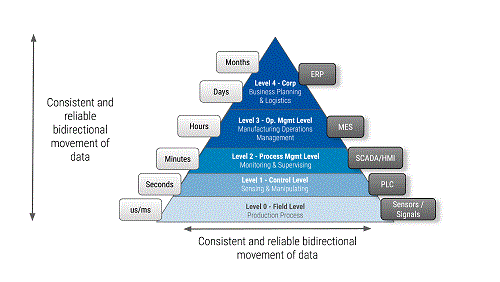Modernizing the Smart Manufacturing Industry with MQTT
Modernizing the Smart Manufacturing Industry with MQTT
Whether you call it Industry 4.0 or the Industrial Internet of Things (IIoT), manufacturing is in the midst of a significant transformation. A key motivation in this push to modernize is that real-time data and dynamic decision-making yield meaningful performance improvements for businesses. Current manufacturing infrastructure is costly to maintain, creates barriers to the distribution of data, integrates poorly with other systems, and blocks corporations from capitalizing on the advantages that digitalization creates. Successful transition to the next generation of manufacturing will require the adoption of new technologies that can integrate outdated existing systems with modern new systems. In this article, we investigate the business drivers for modernization and recommendations for linking the different levels of automation in a factory with new MQTT-based messaging infrastructure. The goal is to provide guidance to senior technology leaders in the manufacturing industry on how the MQTT protocol can serve as the key technology for developing the modern connected smart factory.
Business Drivers to Create Smart Factories
Businesses today face the question of how to make machines smarter, processes leaner, factories more efficient, and productivity higher. The proliferation of sensors in manufacturing environments provides a phenomenal amount of valuable data. Advances in cloud computing make it possible to integrate machine learning, artificial intelligence and advanced analytics to quickly respond to the changing dynamics on the factory floor. Movement is toward a more flexible form of manufacturing that improves factory efficiency and optimizes intra-facility logistics. Measuring and increasing overall equipment effectiveness (OEE) is a central element of the process:
● Increase the availability of equipment by avoiding unplanned downtime
● Ability to analyze everything and continuously increase the quality of production
● Fine-tune the performance of machines and processes
The end result of the drive toward modernization is the digitization of manufacturing to create smart factories.
Levels of Integration to Achieve Smart Manufacturing
The key to modernization is breaking down the silos of data that exist at different levels of automation. In OT, an automation pyramid is frequently used to visualize system requirements. To completely integrate a factory, consistent and reliable bidirectional movement of data within and between levels must be present.

Connecting the Smart Factory with MQTT
The MQTT messaging protocol is well suited to be the standard for new messaging systems within a factory. MQTT is an ISO 20922 standard that has become the de-facto standard for connecting IoT devices and is increasingly popular within smart manufacturing and Industry 4.0. The publish/subscribe architecture of MQTT is what makes it so interesting as a messaging protocol for manufacturing modernization projects. This architecture decouples communication between the different clients which allows different vendors and different systems to implement MQTT independently. All MQTT clients push data to a central MQTT server/broker that forwards the message to the subscribing clients. MQTT clients can include factory equipment, specialized sensors and actuators, SCADA systems, MES, etc. Each of these clients can send and receive data in a format that is independent of a vendor-proprietary protocol. Having different vendors implement MQTT support for their systems creates interoperability between the many different systems deployed in a factory. MQTT supports bi-directional messaging between various clients. The publish/subscribe protocol allows for telemetry data to be sent from factory equipment to the cloud. At the same time, an enterprise manufacturing system can generate a command to be sent down to the factory floor. The central MQTT broker tracks all the client connections and the subscribed topics for each of the clients. Integration with existing security systems is easily achieved with MQTT. MQTT messages can be sent using TLS to ensure that data is sent through a secure channel. MQTT brokers are able to integrate with existing authorization and authentication systems to achieve device authentication and roles-based authorization for directing MQTT messages.
Conclusion
Many manufacturing organizations are beginning the process of modernizing their factory operations to achieve greater efficiency and flexibility. This modernization process requires a substantial upgrade of the existing software infrastructure. A cornerstone of factory modernization is the ability to break down the data silos that prevent a business from obtaining an accurate picture of their overall operation. Several factors favor use of MQTT as the standard protocol for modernizing the messaging infrastructure of a factory. The MQTT protocol uses a publish/subscribe architecture that efficiently moves data between factory equipment, factory OT systems (MES and SCADA), and enterprise IT cloud services. MQTT also provides the bi-directional messaging that a scalable, reliable, and secure messaging system requires. Due to its performant scaling capabilities, 100% implementation of all MQTT 5 features, and professional support services the HiveMQ Enterprise MQTT broker is well suited as the MQTT platform used to operate the messaging system that is needed for modern digitized manufacturing.
Read the full article for more information on modernizing with MQTT.
